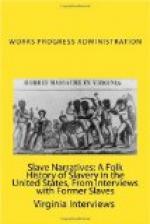We wore tow linen clothes in summer and jeans in winter. Sister wore linsey in winter of different colors, dyed from herbs, especially poke berries; and wore unbleached cotton in summer, dyed with yellow mustard seed.
My grandfather, Jim Embry mended shoes and made fairly good ones.
There were four slaves. My mother did cooking and the men did the work. Bob Wheeler and Arch Bogie were our masters. Both were good and kind to us. I never saw a slave shipped, for my boss did not believe in that kind of punishment. My master had four boys, named Rube, Falton, Horace, and Billie. Rube and me played together and when we acted bad old Marse always licked Rube three or four times harder then he did me because Rube was older. Their daughter was named American Wheeler, for her mother.
White folks did not teach us to read and write. I learned that after I left my white folks. There was no church for slaves, but we went to the white folks church at Mr. Freedom. We sat in the gallery. The first colored preacher I ever heard was old man Leroy Estill. He preached in the Freedom meeting house (Baptist). I stood on the banks of Paint Lick Creek and saw my mother baptized, but do not remember the preachers name or any of the songs they sung.
We did not work on Saturday afternoon. The men would go fishing, and the women would go to the neighbors and help each other piece quilts. We used to have big times at the corn shuckings. The neighbors would come and help. We would have camp fires and sing songs, and usually a big dance at the barn when the corn was shucked. Some of the slaves from other plantations would pick the banjo, then the dance. Miss Americe married Sam Ward. I was too young to remember only that they had good things to eat.
I can remember when my mothers brother died. He was buried at the Wheeler, but I do not recall any of the songs, and they did not have a preacher. My mother took his death so hard.
There was an old ash hopper, made of slats, put together at the bottom and wide at the top. The ashes were dumped in this and water poured over them. A drip was made and lye caught in wooden troughs. This was then boiled down and made into soap. My mother let me help stir it many a time. Then the big kettle would be lifted from the fire and left until cold. My mother would then block it off, and put on a wooden plank to dry out until ready for use.”
Bibliography:
Interview with Dan Bogie, Ex-Slave.
Garrard County. Ex-Slave Stories.
(Eliza Ison) [HW: Ky 13]
Interview with George Henderson:




